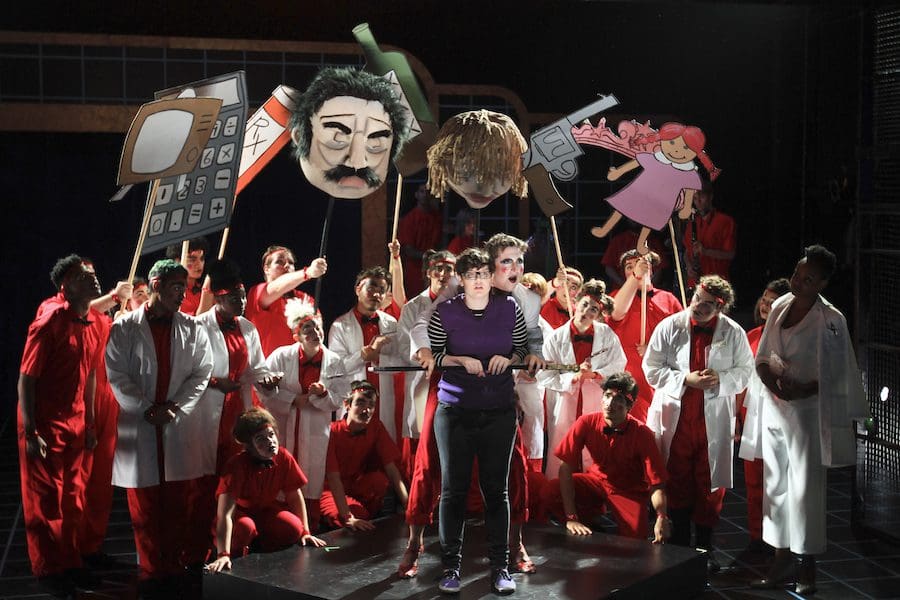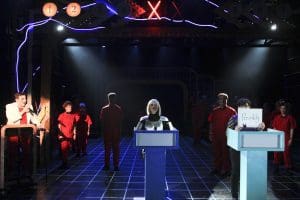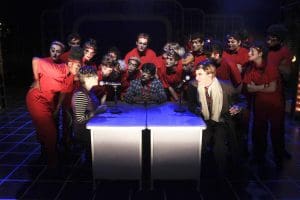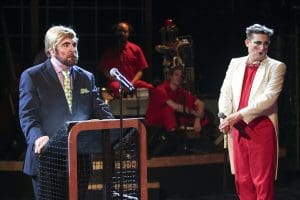The Embedded Joy of The Elementary Spacetime Show
“How can we look at one of the most terrible things that happens in our society and try to find some hope, some way of thinking about it that doesn’t gloss over it but also doesn’t send us all spiraling into sadness?” writer and composer César Alvarez ponders. We’re discussing the great challenge at the heart of his latest production, The Elementary Spacetime Show, a musical that grapples with teen suicide and the difficult questions of existence that arise in the face of an enigmatic universe. Oh, and it’s also a vaudevillian comedy set in an absurd cosmic game show.
So, how does an artist best address such difficult subject matter with enough gravitas and humor to leave audiences feeling changed for the better? The answer, as Alvarez sees it, lies in the show’s form itself. “No other form has the embedded joy that a musical has, the antidote to that kind of sadness,” he asserts. There’s no doubt that The Elementary Spacetime Show possesses this sense of joy with it’s enthusiastic young cast, uptempo music, and dazzling gameshow set, but in talking with Alvarez it becomes clear just how joyous realizing this show has been. Developed largely in conjunction with the University of the Arts and sporting a cast featuring wildly talented UArts students, the show is the product of a radical experiment in combining education and new musical development. Through its success, Alvarez has helped chart a new path for how great, unconventional musicals like it can get produced.
As an artist-in-residence at UArts, Alvarez and former director of the Brind School Joanna Settle launched Polyphone back in 2015. Conceived as a forum to explore the musical’s creative future, the annual festival creates much needed space for forward-thinking new musicals to develop. Five concert productions are mounted in just six weeks time with the help of UArts students. It’s an intensive process, but one that affords each creative team invaluable time and resources to hone their shows and work on their craft, and it’s time they’ve taken full advantage of. “For every single show there’s been all sorts of new songs written, new things added, huge changes, different big conceptual risks taken, and the students get to be in the room for all of that and be a part of the process,” Alvarez says.
That inclusion of students is a big part of what makes Polyphone’s model so special. Involved in different aspects of design, tech, and performance, students are far more than mere observers. It’s a rare opportunity for these burgeoning theater artists to, as Alvarez puts it, “write themselves into the histories of these musicals in a very concrete way,” but perhaps more importantly it invites them to be a part of the conversation about what’s next for their form. Alvarez ensures that Polyphone’s curation reflects the potentials. “We’re trying to create a little microcosm of the field we want to see, which is diverse, genre bending, boundary crossing, rather than formulaic and aesthetically rigid,” he says. “A big goal of Polyphone is that all of these students see the arts with a very wide aesthetic understanding of what a musical can be.”
The Elementary Spacetime Show was among Polyphone’s inaugural offerings. Following its rapturous acclaim from audiences as well as the major impact it had on UArts’ campus, Settle decided to mount a full production as part of the school’s performance season. Given that the show examines teen suicide and requires a multitude of teenage performers, staging it at the university made perfect sense logistically. What’s more, the young performers had connected deeply with it. Now, a year and half since the show’s first concert production, even in the face of such harrowing subject matter, these students have assuredly risen to the occasion and fostered something remarkable. “We’ll be doing these rough stagings and the absolute heart-rending intensity that the students are bringing to this is magnificent, and it’s really moving,” Alvarez tells me. “The experience that we’ve had with the piece is that it’s not depressing at all, it’s cathartic. It’s an opportunity to talk about, laugh about, cry about the thing you never get to talk about.”
It’s difficult to imagine some alternate history where The Elementary Spacetime Show is developed as a major broadway musical. This is, of course, not for lack of quality, but rather what might be perceived as it’s risky subject matter. Without such big conceptual risks though, where’s the reward? The basic elements that make up musicals—the music, singing, dancing—are all intrinsically joyous, sure, but a show that employs them simply to meet structural demands will always be far less gratifying than one that relies on them, clings to them even, to find some solace, beauty, or hope amid painful realities. Thankfully, The Elementary Spacetime Show offers us this kind of truly joyous, transformative experience, one that could only be told as a musical. Its success and the continuing success of Polyphone inspires hope that great things are in store for the American musical.
—Hugh Wilikofsky







